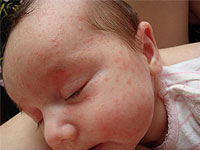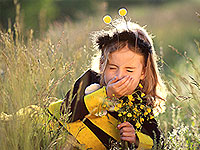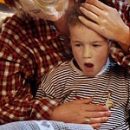Without the realization of the nature of the symptoms of allergy in children, its treatment is impossible. What types of allergens are, and what else can cause allergies in a child?
Content
 Allergy — This is not a separate disease, it is a lot of diseases based on immunological reactions. Sometimes, not aware of the nature of the problem, parents eliminate the manifestations of drugs with drugs and infringement means, but as soon as the treatment ceases, the symptoms of allergies in children flashed again. Over time, addictive to drugs is developing, and when the drug will be vital, it will be extremely low. You can save a child from allergies only by setting its cause and finding out the nature of allergen.
Allergy — This is not a separate disease, it is a lot of diseases based on immunological reactions. Sometimes, not aware of the nature of the problem, parents eliminate the manifestations of drugs with drugs and infringement means, but as soon as the treatment ceases, the symptoms of allergies in children flashed again. Over time, addictive to drugs is developing, and when the drug will be vital, it will be extremely low. You can save a child from allergies only by setting its cause and finding out the nature of allergen.
Types of allergens
Allergy — The reaction of the hyper-sensitivity of the immune system arising from the exposure to the environment, that is, allergen.
All allergens are divided into two main groups:
- Exogenous allergens — Those that enter the body from the outside;
- Endogenous allergens — Form inside the body of the baby and cause an allergic reaction.
Allergens can affect the body through the skin, mucous membranes of the eyes, lips, oral cavity, genital organs. For example, dermatitis can occur as an allergy to powder in children whose mothers use «Adults» Washing powders. Allergens may fall into the digestive tract during food intake, in the respiratory tract — together with the stream of air, in blood — in insect bite and injections. Sometimes allergens become drugs, so develops allergies to antibiotics in children.
The clinical picture of allergy depends on the penetration paths of allergens. So, with food allergies, symptoms have symptoms from the gastrointestinal tract and skin. When inhalation of allergen, sneezing arises, runny nose, rubbed in the eyes, swelling.
By the origin of allergens can be divided into noncommunicable and infectious.
Noncommunicable allergens
- Food allergens;
- industrial allergens;
- Medicinal preparations (allergies to antibiotics in children);
- household allergens (dust and dust mites, fungi, household chemicals, as in the case of allergy to powder in children);
- Latex allergens — Medical gloves, nipples and pacifiers;
- Insect allergens (allergies in mosquito bite, flea, ticks);
- Allergens of pollen plants;
- Animal allergens (wool, sweat, saliva, epidermis particles pets — Cause of widespread allergies for cats in children).
Infectious allergens
- viruses;
- bacteria;
- mushrooms.
Separate types of allergies in children
Allergy to pollen or pollinosis
Polynosis develops as an allergic reaction to pollen plants. Typical allergy symptoms in children develop during flowering «harmful» Plants, pollen penetrates the body through the nose, the oral cavity, the conjunctival of the eyes, the skin, the manifestation of half ancode becomes allergic rhinitis, conjunctivitis, stomatitis, dermatitis and bronchial asthma.
Allergy to Latex
Natural Latex — Complex biological material, its composition includes more than 200 proteins, 17 of them can act as allergens. In the body of the child, the latex allergens penetrate in contact with the skin and mucous membranes, as well as inhalation, causing the symptoms of contact dermatitis and respiratory disease. The presence of allergies to latex is often combined with intolerance of fresh fruit. Latex is made by surgical gloves, leukoplasty, elastic bandages, inflatable mattresses, diving masks, stamps, balloons, paints, nipples and pacifiers for children.
Allergy to animals
Children sometimes suffer from the intolerance of birds and animals, in particular dogs, wavy parrots, rabbits, hamsters, guinea pigs, rats, but most often there is an allergy to cats. In children, allergens become wool, epidermis, saliva and other biological fluids of domestic pets.
Allergy to home dust
This type of allergy is not associated with inorganic dust substances, but with the dust mites and organic fragments of living organisms contained in it. The composition of home dust includes such allergens as cellulose, fragments of wool and dandruff animals, natural fabrics, epidermis and hair of people, spores of mold mushrooms — All these allergens are able to cause a child's disease.
Allergy to insects
It develops upon contact with small particles of the chitin shell of insects, their excrement, when bite. Most often is the allergies of mosquito bites, blinding, flies, bugs, OS and bees. Dermatitis can develop when contact with cockroaches, butterflies, grasshoppers.









